Introduction
Hey there, fellow rabbit enthusiasts! Are you worried about the safety of your adorable furry friends when it comes to nighttime predators?
we’re going to dive deep into the world of nighttime protection for rabbits. We’ll explore the predators they face, including sly foxes, dexterous raccoons, and swooping owls.
First things first, let’s understand the predators. We’ll dig into the characteristics of these nocturnal hunters, from the foxes’ intelligence and agility to the raccoons’ knack for manipulation and the owls’ silent swoops.
Next up, we’ll focus on providing a predator-proof shelter for our bunnies. We’ll talk about choosing the right location, installing sturdy fencing with small gaps, and reinforcing the burrow with materials like bricks or concrete.
But protecting rabbits doesn’t stop at building a safe shelter. We’ll look into the importance of regular monitoring and vigilance.
We’ll even toss in the option of using surveillance equipment to keep an eye on our bunnies when we’re not around.
And we won’t leave out our friends who allow their rabbits to roam freely during the day. We’ll share some additional precautions like creating smaller safe enclosures, using portable electric fencing, and providing secure hiding spots within the free-range area.
So, whether you’re a rabbit owner, a wildlife enthusiast, or simply curious about how to protect these adorable creatures, this article is tailor-made for you. Together, we’ll learn how to safeguard rabbits from nocturnal predators, create rabbit-friendly gardens, protect wild rabbits, and even explore innovative technologies for monitoring and deterring rabbit predators.
So, grab a cup of tea, get cozy, and let’s dive into the world of nighttime protection and predator prevention for our beloved rabbits!
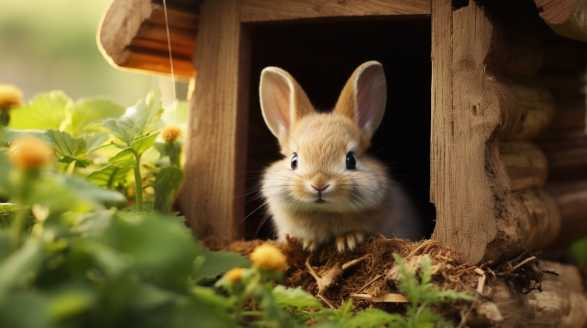
Key Takeaways
- Nocturnal predators such as foxes, raccoons, and owls pose a threat to rabbits.
- Creating a predator-proof shelter is essential, including choosing the right location and installing sturdy fencing.
- Additional protective measures like motion-activated lights, predator deterrents, hiding spots, coyote rollers, and elevated platforms can enhance safety.
- Regular monitoring and vigilance are crucial, including inspecting the shelter and observing the surroundings for any signs of predators.
- Additional precautions for free-ranging rabbits include creating smaller safe enclosures, using portable electric fencing, and providing secure hiding spots.
- Recognizing and understanding common rabbit predators is crucial for their protection.
- Companion planting can be an effective way to prevent rabbit attacks by selecting plants that repel rabbits or make the garden less appealing to them.
- Creating a rabbit-friendly habitat in the wild involves providing suitable vegetation, shelter, and water sources.
- Encouraging natural predators and minimizing human disturbance can help protect wild rabbits.
- Innovative technologies such as motion-activated cameras, GPS tracking systems, ultrasonic devices, electric fencing, and machine learning algorithms can monitor and deter rabbit predators.
Nighttime Protection: Keeping Rabbits Safe from Nocturnal Predators
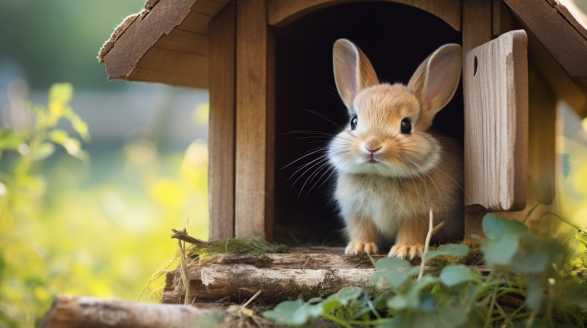
As a rabbit enthusiast, one of the biggest concerns I have is ensuring the safety of my furry friends, especially during the nighttime when predatory animals become more active. With their small, defenseless bodies, rabbits are particularly vulnerable to nocturnal predators such as foxes, raccoons, and owls.
Understanding the Predators
Before discussing nighttime protection strategies, it’s essential to have a basic understanding of the predators we’re up against. Here are some common nocturnal predators that pose a threat to rabbits:
- Foxes: These sly creatures are known for their intelligence and agility, making them formidable opponents for rabbits. Foxes have sharp teeth and claws, enabling them to chase and catch small animals.
- Raccoons: Known for their dexterity and ability to manipulate objects, raccoons are opportunistic feeders who will not hesitate to target rabbits. They are skilled climbers, capable of infiltrating areas you might not think were accessible.
- Owls: These silent hunters are masters of the night skies. With razor-sharp talons and exceptional eyesight, owls can swoop down on unsuspecting rabbits in a matter of seconds.
Now that we have a clearer picture of the threats rabbits face, let’s explore some nighttime protection strategies that can help keep them safe.
Providing a Predator-Proof Shelter
Creating a secure shelter for your rabbits is of paramount importance. Here are some tips to make their burrow safe from nocturnal predators:
1. Choose the Right Location
Select a sheltered spot away from dense vegetation or areas with high predator activity. Ideally, the location should have a clear line of sight to enable you to monitor any potential threats.
2. Opt for Sturdy Fencing
Install a wire mesh fence with small gaps that predators cannot squeeze through. Ensure that the fence goes underground as well to prevent burrowing predators from gaining access.
3. Reinforce the Burrow
Line the inside of the rabbit burrow with durable materials such as bricks or concrete to make it more resistant to predators digging from outside. Remember to regularly check for any signs of damage or weakness.
Implementing Additional Protective Measures
While a secure shelter goes a long way in protecting rabbits from nocturnal predators, there are several supplementary steps you can take to enhance their safety:
1. Install Motion-Activated Lights
Predators generally prefer to hunt in the dark, so installing motion-activated lights around the shelter and the surrounding area can startle and deter them from approaching. This can significantly decrease the likelihood of an attack.
2. Employ Predator Deterrents
Consider using natural deterrents such as predator urine or scents. You can purchase these from specialized stores or attempt to make your own by soaking rags in vinegar or strong-smelling spices.
3. Offer Hiding Spots
Create hiding spots within the rabbit enclosure by placing dense shrubs or bushes. These hiding spots give rabbits a safe haven to retreat to if a predator is nearby.
4. Use Coyote Rollers
Coyote rollers are cylindrical devices installed on top of fences to prevent predators from gaining a foothold. These rollers make it difficult for animals like raccoons and foxes to climb over the fence and access the rabbit area.
5. Provide Elevated Platforms
Owls are less likely to attack rabbits if the latter have elevated platforms to escape to. Place sturdy objects such as large logs or wooden planks that rabbits can use as perches to avoid being an easy target.
Monitoring and Vigilance
No matter how secure your precautions are, it’s crucial to remain vigilant and keep an eye out for any potential threats. Here are a few key points to remember:
1. Regularly Inspect the Shelter
Frequently check the rabbit shelter for signs of damage, weaknesses, or any attempts by predators to access it. Repair any issues promptly to ensure its integrity.
2. Observe Your Surroundings
Regularly survey the area surrounding the rabbit enclosure for any signs of predators or suspicious activity. Look for tracks, droppings, or disturbances in the environment that might indicate a nearby threat.
3. Utilize Surveillance Equipment
Consider setting up a security camera system that covers the rabbit shelter and its surroundings. This will allow you to keep an eye on your rabbits even when you’re not physically present, providing an additional layer of protection.
Additional Precautions for Free-Ranging Rabbits
If you allow your rabbits to roam freely during the day, there are a few extra measures you can take to protect them from nocturnal predators:
1. Create a Smaller Safe Enclosure
Establish a smaller enclosed area within the larger free-range space that rabbits can retreat to at night. This secondary enclosure should be predator-proof, providing rabbits with a safe place to sleep and rest.
2. Use Portable Electric Fencing
Portable electric fencing can be a valuable tool for keeping predators at bay. Set it up around the secondary enclosed area to provide an extra barrier of protection during nighttime hours.
3. Provide Secure Hiding Spots
Introduce natural hiding spots, such as dense shrubs or artificial shelters, within the free-range area. These areas give rabbits a quick escape when they sense the presence of predators.
Safeguarding rabbits from nocturnal predators requires careful planning and implementation of protective measures. By providing a secure shelter, implementing additional precautions, and remaining vigilant, you can help ensure the safety and well-being of your beloved rabbits, even in the face of potential nightly threats.
Remember, regular maintenance, inspections, and adjustments should be carried out to keep the protective measures effective. With proper nighttime protection, you can create a safe haven for rabbits to thrive and enjoy their lives without fear.
Recognizing Rabbit Predators: Identifying and Understanding Threats
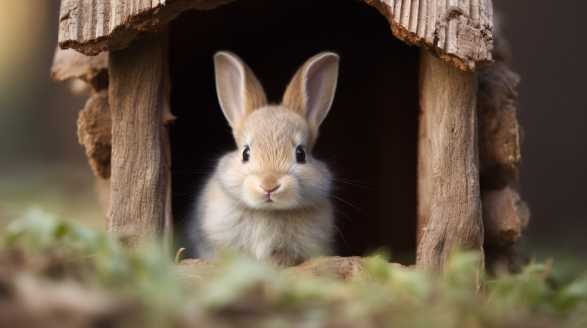
As a rabbit owner and enthusiast, I have always been interested in understanding the potential threats that these adorable creatures face. Recognizing and identifying rabbit predators is crucial in ensuring the safety and well-being of our furry friends.
Understanding the Importance of Rabbit Predators
Rabbits are small, herbivorous animals that are widely preyed upon in the wild. Being aware of the predators that pose a threat to rabbits can help us provide a safe environment for them, whether they are living in the wild or as domestic pets.
Common Rabbit Predators and Their Characteristics
Canines
Canines, such as dogs and foxes, are prominent predators for rabbits. These predators are highly skilled at hunting and have a keen sense of smell, making rabbits an easy target.
Felines
Felines, including domestic and feral cats, are natural predators due to their hunting instincts. Cats tend to be stealthy and rarely give chase to their prey.
Birds of Prey
Birds of prey, such as hawks, eagles, and owls, pose a significant threat to rabbits, especially when they are out in the open. These soaring predators have sharp talons and beaks that can easily incapacitate a rabbit.
Snakes
While not as common as other predators, some species of snakes, like pythons and rat snakes, have been known to prey on rabbits. These serpents use their incredible stealth and constricting abilities to subdue their victims.
Raccoons
Raccoons are highly adaptable and intelligent predators, known for their mask-like facial markings. They are capable of raiding rabbit hutches and can cause significant harm to rabbits if given the opportunity.
Weasels
Weasels are agile predators with a slender body that allows them to enter small spaces, making them difficult to exclude from rabbit enclosures. They have a high metabolism, requiring constant hunting, and their sharp teeth and claws make them formidable predators for rabbits.
Preventive Measures: Keeping Rabbits Safe
Now that we have identified common rabbit predators, it’s crucial to implement preventive measures to ensure the safety of our fluffy companions. Here are several steps you can take:
- Secure Enclosures: Make sure the rabbit hutch or enclosure is predator-proof by using strong materials like wire mesh, buried fencing, and locks on entrances.
- Add Predation Deterrents: Install predator deterrents such as motion-activated lights, noise-making devices, or even guard animals like dogs, which can deter potential predators.
- Utilize Cover and Hiding Places: Provide your rabbits with hiding spots, such as tunnels or dense vegetation, to minimize their visibility and vulnerability to predators.
- Keep Rabbits Inside at Night: Predators are most active during the night, so it’s recommended to bring your rabbits indoors or provide a secure, enclosed space for them during nighttime hours.
- Eliminate Food Sources for Predators: Avoid leaving pet food outdoors, as it can attract predators to your property. Keep your yard clean and free of debris that may attract prey animals and, subsequently, predators.
- Regularly Inspect Enclosures: Conduct routine checks to identify and repair any weak spots or potential entry points that could be exploited by predators.
- Educate Yourself: Continuously learn about rabbit predators and be aware of any new threats in your area. Stay up to date with local wildlife management agencies and seek advice from experienced rabbit owners.
Understanding and recognizing rabbit predators is crucial in protecting these adorable creatures. By taking preventive measures and implementing security precautions, you can ensure the safety and well-being of your rabbits.
Preventing Predators with Companion Planting: Rabbit-Friendly Gardens
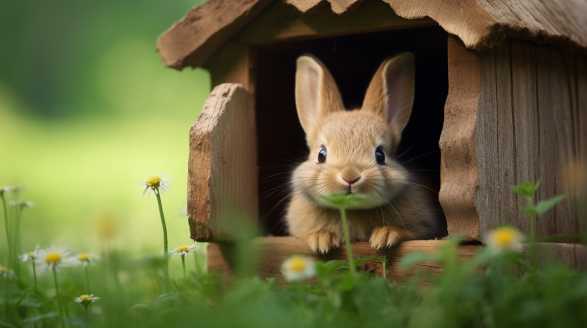
As a gardener who loves both growing plants and protecting wildlife, one challenge I’ve faced is keeping predators, especially rabbits, away from my garden. These cute creatures may be adorable to look at, but they can wreak havoc on your plants if left uncontrolled.
I’ll share some valuable insights and techniques to help you create a rabbit-friendly garden using the power of companion planting.
Understanding the Importance of Companion Planting
Companion planting involves strategically pairing plants to enhance growth, deter pests, and maximize overall garden health. By selecting specific plants that naturally repel rabbits or make the garden less appealing to them, we can create an environment that is less likely to be foraged upon.
Choosing the Right Rabbit-Repelling Plants
When it comes to preventing rabbit attacks, there are several plants known for their repellent properties. Incorporating these rabbit-repelling plants into your garden can significantly reduce the likelihood of rabbit damage.
- Marigolds: These vibrant annual flowers not only add beauty to your garden but also emit a strong smell that repels rabbits. Planting marigolds along the borders of your garden can create a barrier that deters them from entering.
- Onions and Garlic: Rabbits dislike the strong scent of onions and garlic, making them excellent companion plants. Planting these veggies among your other plants can act as a natural deterrent.
- Lavender: Known for its fragrant flowers, lavender is a fantastic addition to any rabbit-friendly garden. Its strong aroma repels not only rabbits but also other common garden pests.
- Rosemary: This aromatic herb is not only a culinary delight but also a natural repellent for rabbits. Planting rosemary near susceptible plants can help prevent rabbit attacks.
Creating a Diverse Garden Landscape
To further deter rabbits from targeting your beloved plants, it’s essential to design your garden in a strategic manner. By incorporating a variety of plants, you can create a visually appealing and rabbit-unfriendly environment.
Plant a Mix of Rabbit-Resistant and Preferred Plants
Choose a combination of plants that rabbits typically avoid, along with some that rabbits find particularly enticing. This will create confusion and uncertainty among rabbits, making them less likely to target your prized plants.
- Sage
- Thyme
- Catmint
- Daffodils
Pair these with some rabbit-preferred plants strategically placed in a separate area of your garden, away from your most vulnerable plants. This will provide an alternative food source for rabbits and keep them away from your cherished flowers and vegetables.
Utilize Vertical Space
Rabbits are more likely to munch on plants that are easily accessible. By incorporating plants that grow vertically, such as trellises or climbing vines, you can reduce the area that rabbits can reach.
- Beans
- Cucumbers
- Climbing roses
These plants not only add height and visual interest to your garden but also create a physical barrier that makes it more challenging for rabbits to access your precious plants.
Additional Rabbit-Proofing Techniques
While companion planting plays a significant role in deterring rabbits, it’s important to combine it with other preventive measures for maximum effectiveness. Here are a few additional techniques to consider:
Install a Rabbit-Proof Fence
Creating a physical barrier around your garden is one of the most effective ways to keep rabbits out. Install a rabbit-proof fence that is at least 2 feet tall, burying it at least 6 inches deep into the ground to prevent them from burrowing underneath.
Remove Potential Rabbit Shelters
Rabbits seek shelter in dense vegetation or brush piles. By removing these potential hiding spots near your garden, you can make your space less attractive to rabbits.
Repel Rabbits with Natural Scents
Rabbits have a keen sense of smell, and there are certain scents that deter them from exploring your garden. Some natural repellents include:
- Cayenne pepper: Sprinkle it around your vulnerable plants to create a spicy barrier that rabbits dislike.
- Blood meal: This organic fertilizer repels rabbits due to its scent. Sprinkle it around your plants as an additional deterrent.
- Predator urine: Many garden supply stores carry predator urine, such as coyote or fox urine, which can be sprayed around your garden perimeter to give rabbits the impression of a predator presence.
By harnessing the power of companion planting and implementing various preventive techniques, you can create a rabbit-friendly garden that protects your plants while still promoting biodiversity. Remember to choose rabbit-repelling plants, create a diverse garden landscape, and utilize additional techniques such as rabbit-proof fencing and natural scents.
Natural Ways to Safeguard Wild Rabbits from Predators
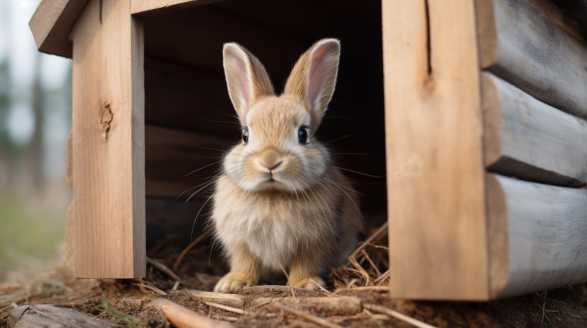
As someone who loves wildlife and has a fascination for rabbits, I’ve always been concerned about their safety in the wild. Rabbits face numerous threats from predators, ranging from foxes and coyotes to birds of prey and snakes.
I’ll share with you some effective methods to protect wild rabbits while maintaining the delicate balance of nature.
1. Create a Rabbit-Friendly Habitat
One of the most fundamental steps in ensuring the safety of wild rabbits is to provide them with a suitable habitat that offers natural protection. Here are some tips on creating a rabbit-friendly environment:
- Planting dense and low-height shrubs and bushes to provide cover and hiding spots for rabbits.
- Creating brush piles or rock formations to offer additional hiding places.
- Providing a suitable nesting area, such as brushy or tall grass patches.
- Planting a variety of native grasses and wildflowers to encourage a diverse and healthy ecosystem.
- Avoiding excessive trimming of vegetation, as this can leave rabbits exposed and vulnerable to predators.
2. Encourage Natural Predators
Believe it or not, the presence of natural predators can actually help protect wild rabbits. Predators play a crucial role in maintaining a balanced ecosystem by controlling the population of prey animals.
- Preserve natural habitat elements that attract predators, such as woodland edges and open fields.
- Providing a water source, such as a small pond or birdbath, to attract predator-friendly wildlife like birds of prey and snakes.
- Avoid using chemical pesticides, as they can harm the predators that help control rabbit populations naturally.
3. Install Rabbit-Friendly Fencing
Installing rabbit-friendly fencing can be an effective way to create a physical barrier between wild rabbits and their predators. Here are some tips for installing the right kind of fencing:
- Choose a fence with small enough gaps to prevent predators like foxes or coyotes from squeezing through.
- Ensure the fence is buried at least 6 inches underground to prevent predators from digging beneath it.
- Opt for a fence that is tall enough to deter predators from jumping over, ideally at least 3 feet high.
- Consider using materials like mesh wire or chicken wire for the fence, as they are durable and provide excellent visibility.
4. Distract Predators with Alternative Food Sources
By providing alternative food sources, you can divert predators’ attention away from wild rabbits. Here are some ideas for distracting predators:
- Plant a separate garden with predator-attracting plants, such as sunflowers or berries, away from the rabbits’ habitat.
- Set up bird feeders or feeding stations for birds of prey to lure them away from the rabbit population.
- Encourage the growth of native plants that attract insects, which in turn serve as prey for snakes and other predators.
5. Employ Natural Predators as a Deterrent
Introducing natural predators in controlled quantities can deter other predators from targeting wild rabbits. Here’s how you can make use of this technique:
- Attract predator species like barn owls or hawks by installing nest boxes or perches in suitable locations.
- Encourage the presence of natural predators by planting vegetation that provides them cover and nesting opportunities.
6. Minimize Human Presence and Disturbance
Human presence and disturbance can alarm and stress rabbits, making them more vulnerable to predators. To minimize these factors:
- Avoid unnecessary disturbances in the rabbits’ habitat, especially during breeding and nesting seasons.
- Limit landscaping or gardening activities near known rabbit habitats, as loud noises or sudden movements can startle them.
- Keep domestic pets, such as cats and dogs, restrained and away from wild rabbit areas.
Protecting wild rabbits from predators involves creating a rabbit-friendly habitat, promoting the presence of natural predators, employing rabbit-friendly fencing, providing alternative food sources, and minimizing human presence and disturbance. By implementing these natural safeguards, we can play a positive role in preserving the delicate balance of nature while ensuring the safety of these delightful creatures.
Creating Rabbit-Friendly Habitats to Prevent Predation
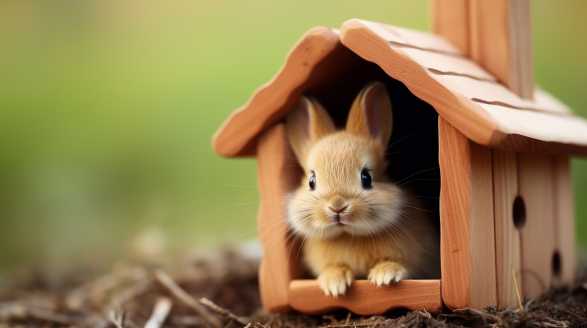
I have always been fascinated by rabbits, so it was no surprise when I decided to create a rabbit-friendly habitat in my backyard. However, I soon realized that providing a safe and secure environment for rabbits comes with its own set of challenges.
But fear not, with a little bit of knowledge and some strategic planning, it is possible to create a rabbit-friendly habitat that minimizes the risk of predation. I will share everything I know about this topic, including tips, tricks, and techniques to keep rabbits safe and happy.
Understanding the Predation Problem
Rabbits are known for their cute appearance and docile nature, which unfortunately makes them vulnerable to predators. Whether it’s dogs, cats, birds of prey, or even humans, these fluffy creatures can fall victim to various predators if not properly protected.
Identifying Common Predators
Before diving into creating a rabbit-friendly habitat, it is essential to know the potential predators you may encounter. Here are some common predators to look out for:
- Dogs: Domestic or unleashed dogs can be a significant threat to rabbits.
- Cats: Stray or feral cats may prey on rabbits if given the opportunity.
- Birds of Prey: Eagles, hawks, and owls are skilled hunters that pose a significant danger to rabbits.
- Foxes: Agile and cunning foxes are natural predators of rabbits and can cause significant harm.
- Snakes: Depending on the region, certain snake species may target rabbits.
Designing a Rabbit-Friendly Habitat
Creating a suitable habitat for rabbits involves a combination of elements that provide safety, food, water, and comfort. Let’s explore the key factors to consider when designing a rabbit-friendly environment.
1. Fencing
A robust and secure fence plays a vital role in protecting rabbits from predators. Here are some considerations to keep in mind when choosing and installing a fence:
- Use a sturdy material such as wire mesh or hardware cloth to prevent predators from squeezing through.
- Ensure the fence is buried at least 6-8 inches below ground to prevent burrowing predators from accessing the habitat.
- Make sure the fence is at least 3 feet high to discourage jumping predators.
- Regularly inspect and repair any damaged areas to maintain the fence’s effectiveness.
2. Vegetation
Creating a natural habitat for rabbits involves incorporating suitable vegetation. Here are some ways to make your habitat more rabbit-friendly:
- Plant dense shrubs and hedges to provide shelter and cover from predators.
- Include tall grasses and meadow-like areas to mimic their natural environment.
- Plant rabbit-friendly herbs and grasses, such as clover, dandelion, and timothy grass, for food and nourishment.
3. Shelter
Rabbits need a safe place to retreat and find shelter from predators. Here are some ideas to provide suitable shelter:
- Build rabbit burrows or digouts. These underground structures mimic their natural burrow systems and offer protection.
- Install rabbit huts or small shelters within the habitat to provide additional safe spaces.
- Use natural materials like logs, stones, or brush piles to create hiding spots.
4. Water Sources
Access to freshwater is essential for rabbits’ well-being. Consider the following when providing water sources:
- Place shallow bowls or trays filled with water within the habitat.
- Install a drip system or small fountain to provide a constant source of running water.
- Keep the water sources clean and fresh, ensuring they are easily accessible to rabbits.
Additional Tips for Rabbit Safety
In addition to designing a rabbit-friendly habitat, consider implementing these extra measures to ensure their safety:
- Avoid using chemical pesticides, herbicides, or fertilizers in and around the habitat, as they can be harmful to rabbits.
- Regularly remove debris, such as fallen branches or rocks, to prevent potential hiding spots for predators.
- Monitor the habitat regularly for signs of predation and promptly address any issues or threats.
- Create noise deterrents, such as wind chimes or motion-activated devices, to scare away potential predators.
- Limit human disturbance in the habitat to reduce stress on the rabbits.
Creating a rabbit-friendly habitat to prevent predation requires careful planning, attention to detail, and a deep understanding of their needs. By implementing the tips and techniques discussed in this article, you can provide rabbits with a safe and secure environment that minimizes the risk of predation.
With dedication and perseverance, you can enjoy the delightful presence of rabbits while knowing you have done your best to protect them from harm.
Innovative Technologies for Monitoring and Deterring Rabbit Predators

If you’re a farmer or someone who loves gardening, you know first-hand how devastating rabbit predation can be to your crops. Those pesky little critters seem to have an insatiable appetite for our hard-earned produce.
I will enlighten you about some truly innovative technologies that can efficiently monitor and deter rabbit predators. Let’s dive in and explore these exciting solutions!
Monitoring Technologies
1. Motion-Activated Cameras
Motion-activated cameras have revolutionized the way we monitor rabbit predators. These cameras are equipped with sensors that detect movement and immediately start recording or capturing images.
2. GPS Tracking Systems
GPS tracking systems have come a long way in recent years, and they’re not just for locating lost smartphones! By attaching these tiny devices to rabbit predators, you can monitor their whereabouts and identify their activity patterns.
3. Radio Frequency Identification (RFID) Tags
RFID tags are small, electronic devices that can be implanted or attached to rabbit predators. These tags emit a unique radio frequency that can be detected by specialized receivers.
Deterrence Technologies
1. Ultrasonic Devices
Ultrasonic devices emit high-frequency sounds that are undetectable to humans but highly effective in driving away rabbit predators. These devices can be placed strategically in your garden or farm to create an uncomfortable environment for the rabbits, deterring them from approaching your precious crops.
2. Electric Fencing
Electric fencing has been a reliable and widely-used rabbit deterrent for years. By electrifying a low-voltage fence, you create a temporary barrier that rabbits find unpleasant when they attempt to breach it.
3. Predator Urine
Nature provides us with some intriguing solutions! Predator urine, such as that from foxes or coyotes, can be an effective tool in deterring rabbit predators.
Integrated Monitoring and Deterrence Systems
1. Automated Predator Deterrents
Imagine having an all-in-one system that combines monitoring and deterrence technologies! These innovative systems integrate motion-activated cameras, ultrasonic devices, and even electric fencing to create a comprehensive solution.
2. Machine Learning Algorithms
Advancements in machine learning have opened up a world of possibilities in deterring rabbit predators. By collecting vast amounts of data from motion-activated cameras, GPS tracking systems, and RFID tags, machine learning algorithms can analyze patterns and behaviors to predict potential predation events.
3. App-Based Monitoring and Control
Gone are the days of manually checking cameras or fences. App-based monitoring and control systems have emerged, allowing you to receive real-time alerts and control your deterrence devices remotely.
The battle against rabbit predators is ongoing, but with these innovative technologies at our disposal, we now have a greater chance of protecting our crops and gardens. From motion-activated cameras and GPS tracking systems to ultrasonic devices and machine learning algorithms, the options are endless.
Conclusion
In conclusion, protecting rabbits from nocturnal predators requires careful planning and implementation of various protective measures. By understanding the characteristics of common rabbit predators like foxes, raccoons, and owls, we can better prepare ourselves to safeguard our fluffy companions.
Additional precautions like motion-activated lights, predator deterrents, hiding spots, coyote rollers, and elevated platforms can enhance safety. Regular monitoring and vigilance, including inspecting the shelter and observing the surroundings, are crucial in keeping rabbits safe.
For those who allow their rabbits to roam freely during the day, creating smaller safe enclosures, using portable electric fencing, and providing secure hiding spots are additional precautions to consider. Recognizing and understanding common rabbit predators is key in their protection.
Creating a rabbit-friendly habitat in the wild involves providing suitable vegetation, shelter, and water sources. Encouraging natural predators and minimizing human disturbance can help protect wild rabbits.
Lastly, innovative technologies can play a crucial role in monitoring and deterring rabbit predators. Motion-activated cameras, GPS tracking systems, and RFID tags allow for efficient monitoring of predators’ movements.
Integrated monitoring and deterrence systems that combine various technologies are available, along with machine learning algorithms and app-based control systems. With these cutting-edge solutions, we now have a greater chance of protecting our beloved rabbits and our crops from predation.
So, whether you’re a rabbit owner, a wildlife enthusiast, or simply curious about how to protect these adorable creatures, the key to nighttime protection and predator prevention lies in knowledge, planning, and vigilance. By implementing the tips and techniques discussed in this article, we can create safe havens for our fluffy companions, whether they are domestic rabbits or wild bunnies.
Frequently Asked Questions
How can I protect wild rabbits from predators?
Wild rabbits can be protected from predators by taking certain measures such as creating a safe and secure habitat, using predator deterrents, and implementing predator-proof fencing.
What are some natural ways to protect wild rabbits?
Some natural ways to protect wild rabbits include providing dense vegetation for cover, planting shrubs and plants that rabbits can hide in, and using natural predator deterrents like good landscaping practices and predator-enticing plants.
How effective are predator deterrents?
Predator deterrents can be very effective in protecting wild rabbits. Common deterrents include motion-activated sprinklers, reflective tape, predator urine, and auditory repellents.
Why is it important to create a safe habitat for wild rabbits?
Creating a safe habitat for wild rabbits is important because it provides them with protection from predators, shelter from harsh weather conditions, and access to food and water sources. A safe habitat increases their chances of survival and allows them to thrive.
What are some common predators of wild rabbits?
Some common predators of wild rabbits include domestic dogs, cats, foxes, coyotes, birds of prey (like hawks and owls), and snakes. It is essential to protect rabbits from these predators to ensure their safety.
Can predator-proof fencing be effective in protecting wild rabbits?
Yes, predator-proof fencing can be highly effective in keeping wild rabbits safe from predators. The fence should be buried at least 12 inches deep to prevent predators from digging under it, and it should have a height of around 2-3 feet to make it difficult for predators to jump over.
Are there any specific plants that can help protect wild rabbits from predators?
Yes, some plants can help protect wild rabbits from predators. Planting thorny and prickly bushes like rose bushes, blackberry, and raspberry bushes can act as natural deterrents and make it difficult for predators to approach. Dense shrubs and ground covers also provide hiding spots for rabbits, offering protection from predators.
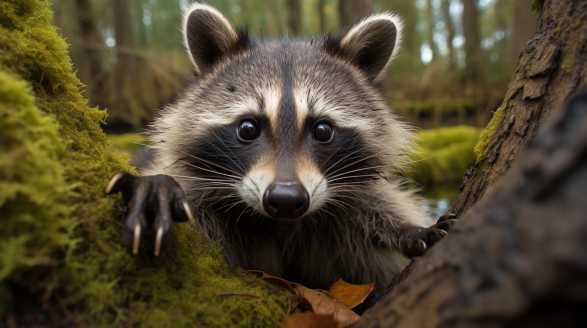
Do Raccoons Eat Rabbits
Introduction Do Raccoons eat rabbits? Let’s find out. Picture this: a moonlit forest, shadows dancing among the trees, and a mischievous raccoon stealthily tiptoeing through the undergrowth. Now, imagine a fleet-footed rabbit, its cotton tail bobbing in the night as it darts through the grass. As we embark on this journey, we’ll uncover the truth […]
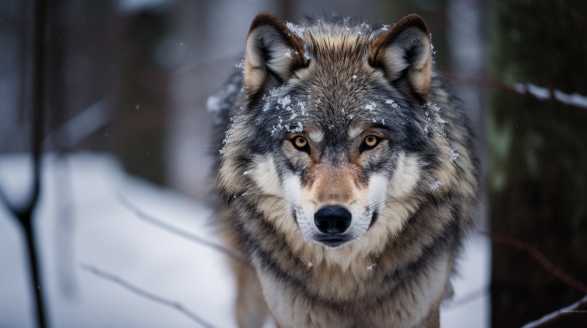
Do Wolves Eat Rabbits
Introduction Do wolves eat rabbits? Let’s find out. Picture this: you’re deep in the wilderness, surrounded by towering trees and the crisp scent of nature in the air. Suddenly, a spine-chilling howl pierces the silence, sending shivers down your spine. But what are they hunting? Well, my friends, it’s those quick and elusive creatures we […]

Do Skunks Eat Rabbits
Introduction Do skunks eat rabbits? As I sit here, pondering the mesmerizing dance between these two creatures, I can’t help but feel a surge of excitement. Skunks with their stinky defenses and rabbits with their lightning-fast speed – it’s a showdown you won’t want to miss! Now, close your eyes and imagine this: a moonlit […]

Do Eagles Eat Rabbits
Introduction Do eagles eat rabbits? Picture this: a majestic eagle soaring through the clear blue sky with eyes so sharp they can spot their prey from miles away. Rabbits, known for their speed and agility, are no match for the skilled hunters we’re about to discover. But the story doesn’t end there! We will also […]

Do Rabbits Play Dead
Introduction Do rabbits play dead? Let’s find out. Picture this: a seemingly innocent rabbit suddenly drops dead in front of a predator’s eyes, only to spring back to life moments later. Can you believe it? Now, I’m just an ordinary nature lover with a thirst for knowledge, and when I stumbled upon this fact, I […]
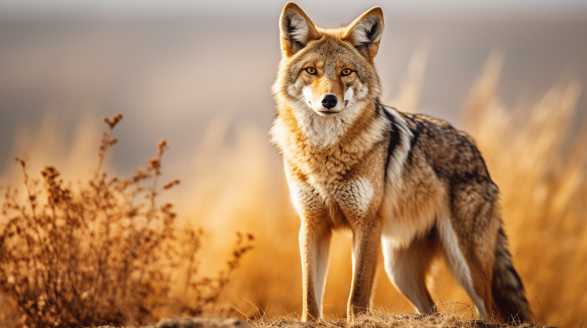
Do Coyotes Eat Rabbits
Introduction Do coyotes eat rabbits? let’s find out. Today, I invite you to join me on an journey into the heart of their epic battle for survival. Imagine standing in the midst of nature’s grand theater, the air thick with anticipation. From the shadows, the wily coyote emerges, its eyes burning with a predatory fire, […]
